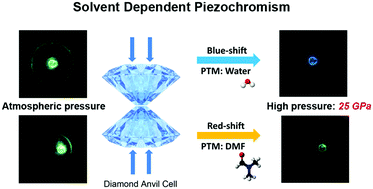There has been a long standing debate on the luminescence origination from carbon nanodots (CDs). Herein, we report the solvent dependent piezochromism of CDs by diamond anvil cells experiment. Red- and blue-shift piezochromism were observed in CDs with N,N-dimethylformamide and water as pressure transmitting medium (PTM) with increasing pressure from atmospheric pressure to 25 GPa, which were related to increased π–π stacking and protic-solvent-induced surface chemical structural changes, respectively. Based on theoretical modeling and structural analysis of hydrothermally treated CDs (h-CDs), the reversible and irreversible piezochromism from green emission to blue emission with water as PTM was attributed to pressure induced enhanced intermolecular hydrogen bonding and addition reaction between water molecules and surface electron withdrawing groups on the CDs, respectively. The decreased electron withdrawing ability of the surface chemical structures of CDs further affects their intrinsic luminescence. This work provides a new understanding of the piezochromic luminescence origination from CDs, which is related to the surface related intrinsic luminescence.
